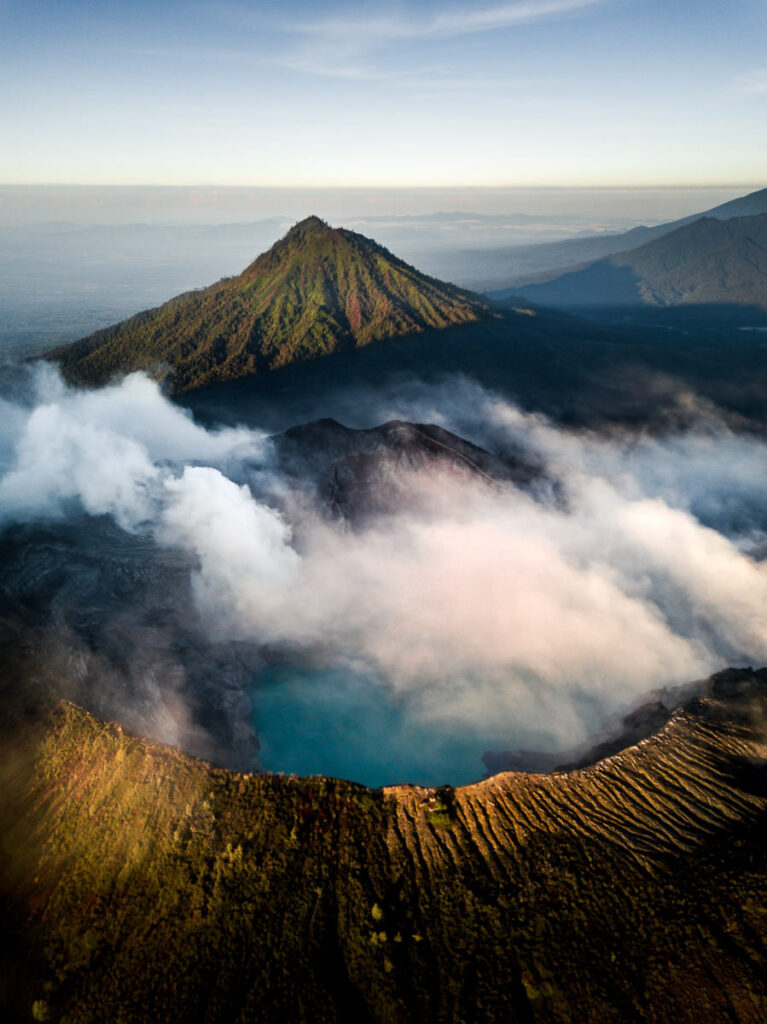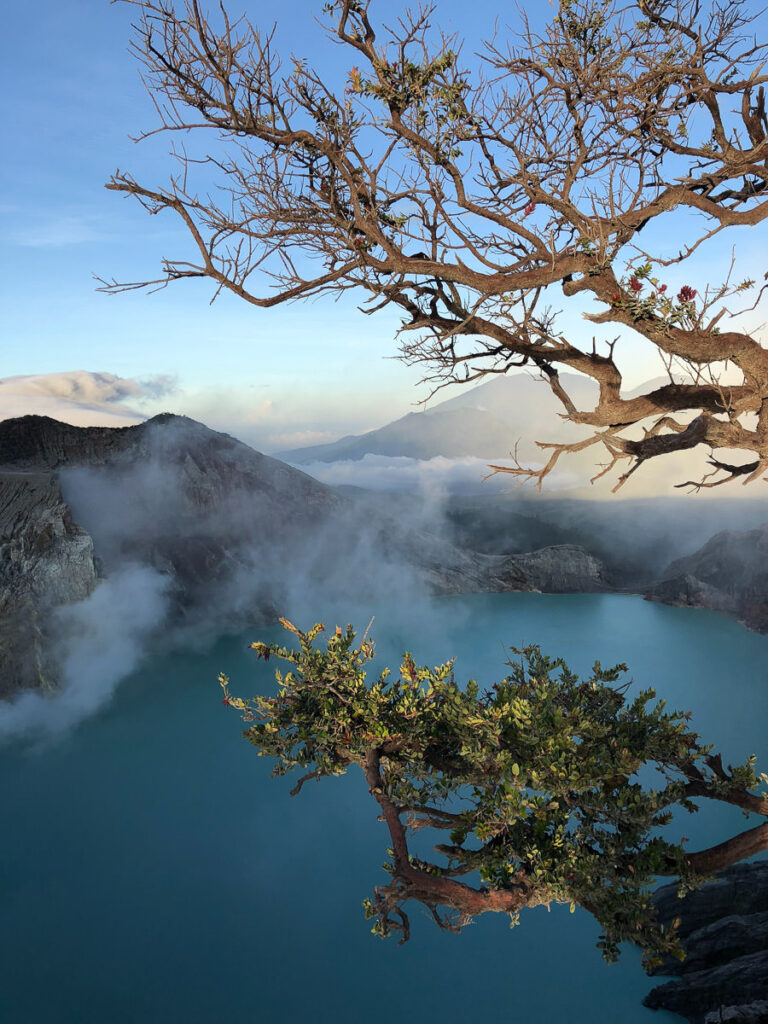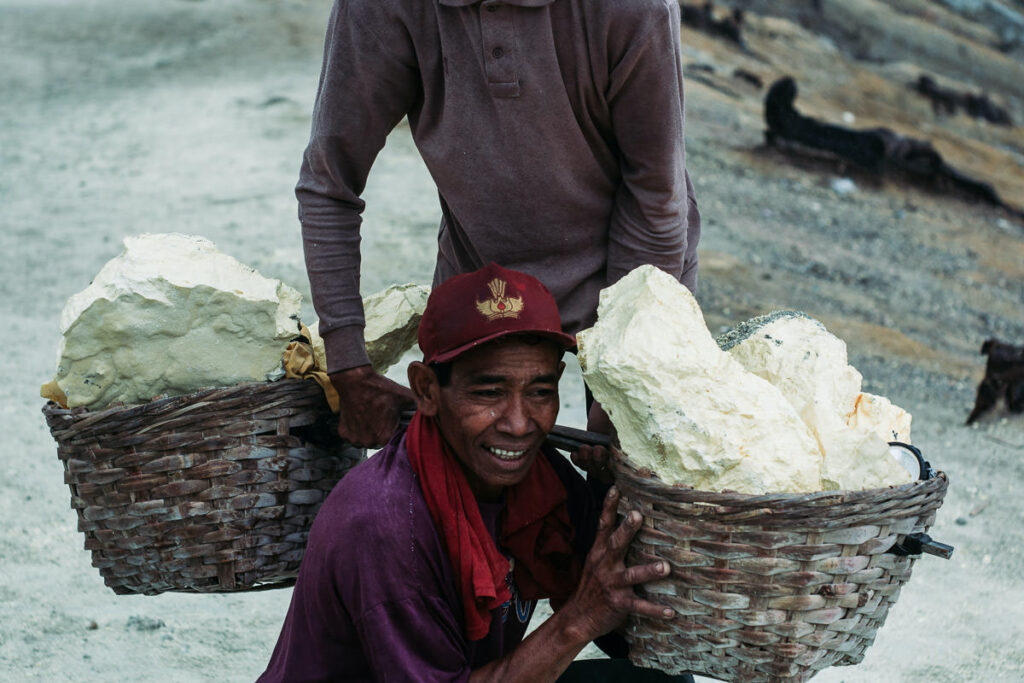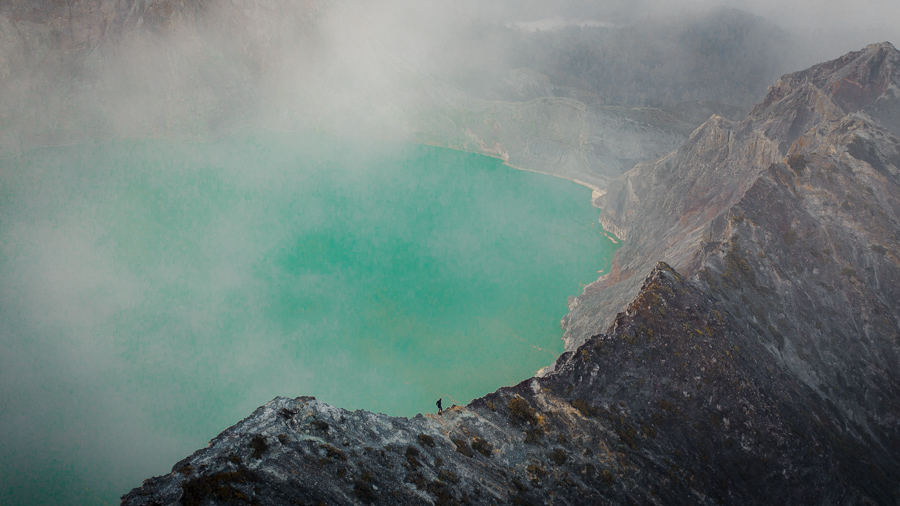Kawah Ijen Volcano, home to the iconic Mount Ijen Crater Lake and its mesmerizing ‘Blue Fire’ phenomenon, is a natural wonder that draws adventurers to East Java from around the world. The highlight of Kawah Ijen is undoubtedly the otherworldly Blue Fire, a rare occurrence that emerges from the depths of the crater, casting an enchanting blue glow. After a tough trek through the night, you venture into the heart of Kawah Ijen, to find the ethereal beauty of the turquoise acidic lake, the rugged volcanic landscape, and the unique sight of sulfur miners toiling in this dramatic environment.
Waking up in the middle of the night and trekking up and then inside a crater sound enticing? Add a gas mask and walk into a cloud of sulfur gas while watching blue flames. Enticed yet? You should be. Trekking up to the Mount Ijen Crater Volcano is one of the most epic adventures in East Java.

KAWAH IJEN VOLCANO: MOUNT IJEN CRATER & BLUE FIRE
In this article, I will share with you all the tips for trekking up Kawah Ijen (Mount Ijen) to the crater lake. I’ll detail important factors such as the time you should leave, what equipment you need, whether a guide or no guide is needed and tips for the best photo spots around Kawah Ijen.
PREPARING FOR IJEN CRATER
Trekking up Mount Ijen Crater is an interesting adventure because you have a few different elements to consider that may be new for you.
- You are waking up in the middle of the night to start the adventure so it will be very cold at times.
- You are going to be hiking in the dark.
- You are going to be very close to toxic sulfur gas as you observe the blue flames inside the crater.
It isn’t your normal hike and this requires a certain level of preparation but nothing too intense.
Preparing for a trek to the Kawah Ijen Volcano Crater in East Java, Indonesia requires some essential considerations to ensure a safe and enjoyable experience. Here are a few tips to help you prepare:
- Physical Fitness: The trek to Kawah Ijen can be physically demanding, involving steep slopes and uneven terrain. The out-and-back trek is 9.3 kilometers in distance with almost 600m of incline but it may be more if you wander around and visit the blue fire.
- Proper Gear: Wear sturdy and comfortable hiking shoes or boots with good traction to navigate the rocky terrain of the Kawah Ijen Volcano Trek. Dress in layers, as the temperature can vary throughout the day so you will want to be able to take off jackets as it gets warmer after sunrise. Bring a windproof jacket, a hat, and sunscreen to protect yourself from the sun for after sunrise. A headlamp or flashlight is crucial for the early morning trek to witness the Blue Fire.
- Respiratory Protection: The sulfuric gases emitted by the volcano at Kawah Ijen can be strong and irritating to the respiratory system. It is highly recommended to bring a respirator mask. If you don’t have one, they can be hired or purchased in the parking lot from locals before the hike starts. Your tour company should provide this.
- Start Early: To witness the magical ‘Blue Fire’ phenomenon at Kawah Ijen, start the trek in the early hours of the morning, preferably around midnight. It all depends on your page but it takes many people about 3-4 hours to reach the top of the crater lake.
- Local Guide: It is highly recommended to hire a local guide who is familiar with the area and can provide valuable insights about the trek and the volcano. They can ensure your safety, offer assistance, and enhance your overall experience.
- Respect the Environment: Remember to practice responsible tourism by following designated trails, refraining from littering, and respecting the local culture and customs. Avoid touching or disturbing any natural formations within the crater.

WHERE TO STAY NEAR KAWAH IJEN
The Ijen Resort & Villas are perfectly located as a base for trekking to Ijen Crater. With breakfast included for when you arrive back from the trek and beautiful rooms, you can catch up on the lost sleep easily! It’s a peaceful spot with nice gardens and air-conditioning so you can recover after the trek.
TOP 3 PLACES TO STAY IN EAST JAVA
ENTRANCE FEE TO IJEN VOLCANO
The entrance fee for foreigners was 150,000 rupiah, which is about $10 USD. For locals and all Indonesians, the fee was only about $1 USD. The team is constantly upgrading the path and adding infrastructure so this fee is quite low considering the popularity of the attraction.

DO YOU NEED A GUIDE FOR KAWAH IJEN VOLCANO TREK
To answer this question you first have to consider your level of experience and what you are willing to figure out on your own. We didn’t have a guide but a local friend helped show us the way. The entrance fee is only $10 USD without a guide.
The main part that required a decent level of know-how was walking down to the blue flame in the dark of the night. I saw many tourists holding onto their guides as they went down the steps. They were scared, in the dark and out of their comfort zone. This is great and even necessary moment to have a guide.
I think if you have done a few trails, hikes, and night hikes in the past, you could be okay without a guide. The best-guided tour that is reliable and can be booked in advance is this one that departs from either Bali or Banyuwangi: Guided Ijen Crater Hike

KAWAH IJEN VOLCANO TOUR I DID (FROM BANYUWANGI)
The Ijen Crater trek is an amazing experience and with an expert guide, you will have a great time. This tour is one of the top-rated tours you can pre-book online and includes hotel pick-up and drop-off from the town of Banyuwangi (where everyone stays before Ijen). Here is some information about what is included in the tour.
You are collected at your accommodation in Banyuwangi at midnight. The journey to the Ijen Crater will take about 1.5 hours. Then the hike to the Ijen Crater viewpoint takes 90-120 minutes from the foot of the path, which leads you to the top. On a clear day, you can see the magical blue fire, which is a truly unique experience.
After witnessing the stunning blue flames from the viewpoint, continue to catch the beautiful sunrise over the largest acid lake on Java Island, called Ijen’s Crater. On the way back to the car park, appreciate the local miners carrying sulfur rock as part of their daily tough life to continue fulfilling their family bread and butter.
After 1-hour trek down, you will reach the car park around 7:00 AM. On the way back you will stop at the coffee and cloves plantation on the way back to your accommodation, which you will reach around 9:00 AM.
Book a tour: Ijen Crater Tour – Blue Flame Experience (Including Transport)

WHAT TIME TO BEGIN THE KAWAH IJEN VOLCANO HIKE
There are a few main things to do consider. Do you want to go down to see the blue flame up close (and inhale sulfur!) and do you want to be at the sunrise point early to prepare or right on time for the sunrise.
We began at midnight from Banyuwangi Town, which is where most people stay. The drive was simple and took an hour. We parked the car, rented our masks, used the toilet facilities on site, finalized our gear and I believe we were on the trail walking by 1:30 am. The sunrise was scheduled for 5:10 am.
We reached the crater within about one hour and half and then spent about 45 minutes going up and down to reach the blue flame. It was then about 3:30 am. We then made the final trek to the sunrise spot, which took about half an hour.
We then had to wait only half an hour at the summit (a bit cold but not freezing) for the colors to start to come through. For us as photographers that was perfect because we prefer to be thirty minutes early than thirty minutes late.
KAWAH IJEN VOLCANO HIKE EXPERIENCE
The trail begins with a sandy incline in the dark at around 1:30 am. Nothing too remarkable happens for the first 45 minutes as you trudge your way up the hill, sweating heavily. With fifteen minutes left before reaching the crater, you begin to realize how high you are. I turned around and saw we were above the clouds as Mt. Rante poked above the cloud line in the distance.

THE BLUE FIRE OF KAWAH IJEN VOLCANO
We reached the tip of the crater edge after about an hour of pretty mild climbing and saw there was already quite a crowd. They were all headed down to the Kawh Ijen blue fire, which occurs near the huge cloud of sulfur gas pouring out of the pipes. Sulfur mining has been underway at Ijen Crater since 1968.
The combustion of the sulfuric gases creates a blue glow, which has become famous as the ‘blue fire of Ijen Crater’. I’m sorry but I didn’t fancy coughing on sulfur for 20 minutes to shoot a long exposure of the blue fire. To be honest it is something best enjoyed with the eye.. for 2 minutes then get the hell out!

Mining companies have installed ceramic pipes on an active gas vent, which speed up the natural processes. The pipes channel the gas down the mountain, condensing it into liquid sulfur, which drips and solidifies into the sulfur collected by the miners.
The miners then have to hit the sulfur with iron bars to break it up, pack it into the reed baskets and carry up to 150 pounds back to the crater rim and then down to the bottom of the trail. Miners make anywhere from $5 -$7 per load. Most miners are reportedly making 1-2 loads per day.

The sulfur cloud is toxic and you will need to wear your filtration mask. I found that I was still breathing in some sulfur and pressed the mask tighter. It helped but it still wasn’t perfect. You are warned before about this and if you have breathing problems or are asthmatic definitely DO NOT go down into the crater.
You can get a good look at the blue fire from a distance and there is no need to push the limit and risk your health to get right up close and personal in the flumes of gas.
The wind will often change direction rapidly and blow all of the gas right into your face, engulfing you for up to a minute in the foul sulfur gas. Don’t stay down here too long. Enjoy the phenomenon and then get the hell out.
KAWAH IJEN CRATER SUNRISE
After the Kawah Ijen blue fire expedition, you head on further up and around the crater rim to the ‘sunrise spot’. It is an interesting spot because a huge mountain actually blocks most of the sunrise. There are some brick bunkers and structures to shelter in as you wait. This is where most of the crowd will be or back at the blue fire area.
Many don’t continue on further than the blue fire as you can actually enjoy the sunrise from anywhere around the crater so for most people that is enough walking for one day!
We decided that we would get away from the crowd and headed further around the rim to an epic knife-edge section that is very dangerous. It was here that we really enjoyed the epic nature and grand scale of Ijen Crater. With no-one else around, huge drop-offs and the ever-changing gas clouds billowing out from the pipes, we felt in a land far, far away.
We stayed up here for hours and finally made it back down as the last ones to leave Ijen crater at 11 am after being up there for 10 hours! It’s just a great place to explore and we wanted to enjoy our moments and hope you do to!
WHERE IS THE MOUNT IJEN CRATER VOLCANO
As you can see from the pinned location on the map below, Ijen Crater is in the far east of Java. In fact, it is so close to eastern neighbor Bali, that many people use Bali as a base for the Ijen Crater tour. However, most people base themselves in Banyuwangi town and then drive one hour to Ijen Crater in the early hours of the morning. This way you can still get a few good hours of sleep before the adventure, which is very important.
ADVENTURE BAG FROM IJEN CRATER HIKE
This is an adventure bag. It is full of trash. Every time I go on an adventure I collect one adventure bag full of trash. It’s my small way of saying thanks to mother nature for allowing me to enjoy her beautiful creations.
If we have time to go on an adventure we have time to collect an adventure bag on the way back out of the trail once we have enjoyed the waterfall, the hike or the beach. Adventure hard!
Tag your @adventurebagcrew on Instagram and mention @adventurebagcrew in your Instagram stories to be featured and inspire your friends, family, and followers to join the movement!

INTERESTING FACTS ABOUT KAWAH IJEN VOLCANO
- Blue Fire Phenomenon: Kawah Ijen is one of the few places in the world where you can witness the mesmerizing Blue Fire phenomenon. It occurs when sulfuric gases from the volcano ignite upon contact with the air, creating a mystical blue glow. This natural spectacle is truly extraordinary and makes Kawah Ijen a unique destination.
- Acidic Crater Lake: The crater of Kawah Ijen is home to one of the world’s largest acidic crater lakes. The turquoise-colored lake is highly acidic, with a pH level of around 0.5. The acidity is caused by the high concentration of sulfuric acid, which results from the volcanic activity in the area.
- Sulfur Mining: Kawah Ijen is renowned for its traditional sulfur mining operations. Miners venture into the crater, enduring harsh conditions, to extract solid sulfur rocks. They carry heavy loads of sulfur up the steep slopes, often using bamboo baskets, to sell in local markets. This unique and labor-intensive mining practice has become an iconic feature of Kawah Ijen.
- Breathtaking Landscapes: The landscapes surrounding Kawah Ijen are truly breathtaking. From the rugged volcanic terrain to the dense forests, the area offers stunning vistas at every turn. The contrast between the vibrant blue lake, the yellow sulfur deposits, and the lush greenery creates a visually captivating scene.
- Rich Biodiversity: Despite the harsh conditions, Kawah Ijen is home to a surprising range of biodiversity. The area supports various plant species, including unique flora that have adapted to the volcanic environment. It is also a habitat for some bird species and small mammals, showcasing the resilience of life in this volcanic ecosystem.

- Volcanic Monitoring: Due to its active status, Kawah Ijen is closely monitored by the Volcanology and Geological Disaster Mitigation Center (PVMBG) to assess volcanic activity and ensure the safety of visitors and nearby communities. Regular monitoring helps to provide early warnings and necessary precautions.
- Sunrise Views: Trekking to Kawah Ijen in the early morning rewards visitors with breathtaking sunrise views. As the sun rises over the volcanic landscape, it bathes the surroundings in warm hues, creating a truly magical experience.
- Nighttime Trekking: To witness the Blue Fire phenomenon, visitors embark on a nighttime trek to the crater. This unique adventure adds an element of mystery and excitement as you navigate the trails with the aid of headlamps, creating an unforgettable experience under the starlit sky.
Kawah Ijen’s fascinating natural phenomena, sulfur mining operations, stunning landscapes, and unique experiences make it a remarkable destination for nature enthusiasts and adventurers seeking something truly extraordinary.

TOP 3 PLACES TO STAY IN EAST JAVA
MORE EAST JAVA TRAVEL GUIDES












